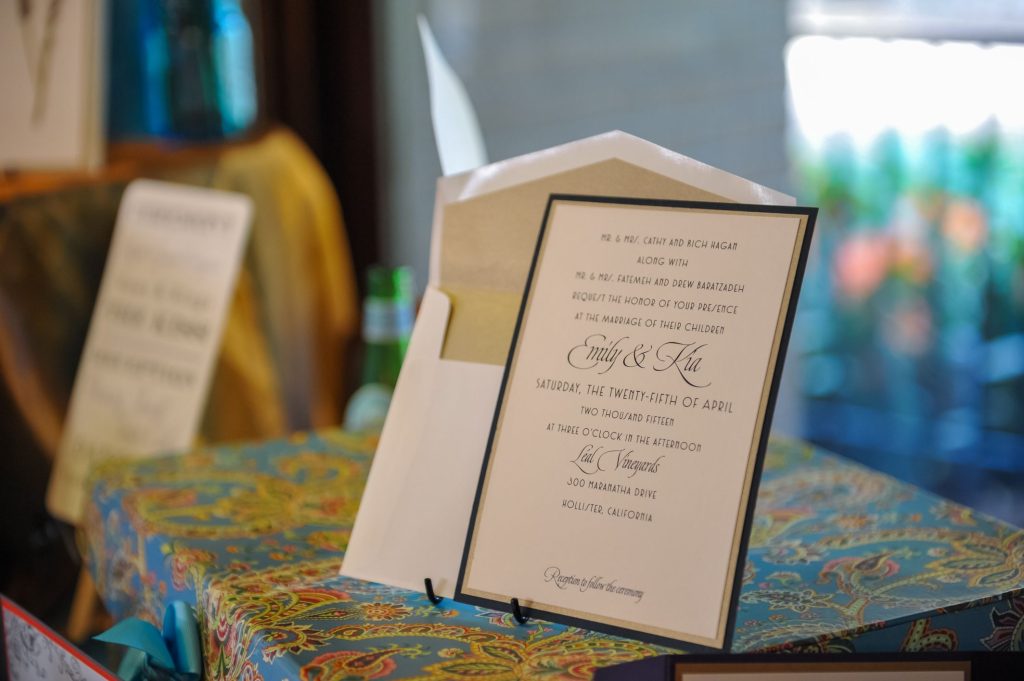As you go into the complicated world of wedding planning, you will encounter endless pieces of etiquette: what is appropriate to wear, who can attend which parties, and so on. Even details like which names appear on what part of the invitation can get quite complex.
While drafting your invitations, you may wonder how to include your parents on the wedding invitation. Traditionally, whoever hosts the ceremony—that is, which family shoulders more of the expenses—goes on top, with the other set of parents going below.
However, as time goes on, new practices emerge, and couples can add twists to traditional etiquette. Below is a detailed guide for including parents’ names on a wedding invitation, followed by additional tips and information.
Parents’ Names on Wedding Invitations: Detailed Guide
Step 1: Understanding the Traditional Wedding Invitation Structure
When including your parents’ names on wedding invitations, the bride’s parents are usually mentioned first. This custom has origins in history; back then, the bride’s family was typically expected to shoulder the wedding expenses. Here is an example:
“Mr. and Mrs. Anderson request the honor of your presence at the marriage of their daughter, Miley Rose, to Eric Liu, son of Mr. and Mrs. Liu….”
This way of structuring the wedding invitation wording remains popular, even if expectations and obligations surrounding financing the wedding have changed.
Step 2: Knowing Who Will “Host” Your Wedding
Simply put, the host of your wedding is whoever—or whichever family—is financially contributing to the event. As mentioned above, the bride’s family has historically carried this responsibility.
The rule of thumb for how to include parents’ names on wedding invitations is that whoever is shouldering more of the expenses will appear at the top of the invitation.
However, more and more families are coming together to contribute equally. In this case, you can write both sets of parents on the upper portion of the invitation. For instance:
“Mr. and Mrs. Jerry White, along with Mr. and Mrs. Vincent Callows, request the honor of your presence at the marriage of Andrea Marie and Lucas Edward Callows….”
“Together with their parents
Lisa and Matthew Weber
Casey and Frederick Brahms….”
Step 3: Reflecting Your Family’s Structure

Every family is unique; its composition varies from one household to another. As you think about including your parents’ names on wedding invitations, exert extra effort to reflect your family structure.
If your parents are divorced, the invitation wording should ideally reflect that. You can do this by separating your parents’ names with a line break, such as:
“Mrs. Riley Larson
along with Mr. Jonathan Larson, request the honor of your presence at the marriage of their daughter, Emily Elizabeth, to Mark Brown, son of Mr. and Mrs. Ronald Brown….”
Alternatively, if your parents have remarried, you can think about potentially including your step-parents in the invitation. If so, you can name them individually or refer to them as your biological parents’ spouses. Here is an example:
“Mr. and Mrs. Nolan Andrews-Butler
along with Mr. Bruno Walters and his spouse, request the honor of your presence at the marriage of their daughter, Simone Louise, to Paul Lima, son of Mr. and Mrs. Jose Lima….”
If you want to honor a deceased parent, you can include phrases such as “the late” after their name. For example:
“Margaret Jane, daughter of Mr. Gianelli and the late Mrs. Gianelli, and Xavier Francis Stephens, son of Mr. and Mrs. Stephens, request the honor of your presence….”
How to Include Parents on Wedding Invitations: Etiquette and Tips

Have an Open Conversation With Your Parents
Before writing your parents’ names on wedding invitations, make sure to consult them first. Workshop potential ways of wording the invitation and ask for their honest opinion.
This step is especially important if you plan on including a step-parent, as one of your biological parents might object to it. Although you have the final say in what goes on the invitation, you should consider their insights and feelings.
“And” Means Married
When including the name of your parents on wedding invitations, be mindful of the simple conjunction “and.” When placed between two names, it connotes that those two individuals are married.
If your parents are divorced, do not use “and” between their names. Separate their names with a line break instead.
Use Full Names and Omit Titles
Using your parents’ full names on the wedding invitation will maintain a formal and sophisticated tone. However, it is also common practice to only use the father’s full name, such as “Mr. and Mrs. Robert Lee,” to refer to both parents.
Other titles, such as occupational ones like Dr. or Atty., are unnecessary in this case. Oppositely, you should include suffixes that distinguish your parents from other relatives, such as Sr., Jr., III, and so on.
Always Double-Check Every Detail
You do not want any typos on your wedding invitations. Before designing and ordering them, make sure to proofread every detail—not just your parents’ names—and correct any errors that you may have missed.
Ideally, ask another member of your bridal party, such as your maid of honor, to double-check the details as well. The more sets of eyes that proofread your invitation, the less likely it is for mistakes to go unnoticed.
Final Thoughts
Wedding etiquette can be difficult to navigate, and something as seemingly minor as parents’ names on wedding invitations can be a controversial topic.
At the end of the day, your wedding invitations should be a reflection of your wedding day: a celebration of love and unity. Do what feels right for you and your partner, be it putting both sets of parents on top of the invitation or creating a unique way to still include them.